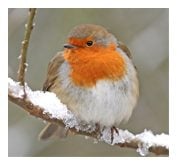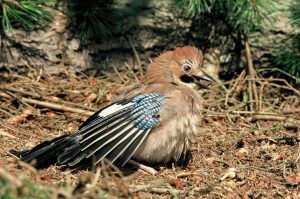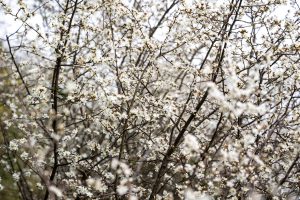Now is the time to increase the food supply for the birds in your garden
This week sees a return to colder temperatures across the UK, and with this we’re already seeing more birds on our feeders at Vine House Farm – and no doubt it’s the same story in your garden.
Although we will of course have some spells of milder weather in the months ahead, the fact is that the days will continue to get shorter for the next five weeks or so (the shortest day of the year is, of course, the 21st December), and therefore our songbirds will need all the daylight hours available to eat enough food to get them through the long cold nights. Plus, the bounty of natural foods which we’ve seen through the autumn – e.g. hawthorn and rowan berries – are fast getting depleted, with much of these being devoured by the influx of the migrant thrushes from northern Europe: namely Fieldfares, Redwings and Blackbirds.
So now is the time to increase the supply of foods for the birds in your garden, and also consider the type and variety.
Starting with the supply, the obvious thing to do is simply put more feeders out – e.g. if you currently have one tube seed feeder then add a second. Why is this important? Well it isn’t just to allow for more birds to feed at any given time but, importantly, it also greatly reduces the energy birds waste fluttering, fighting and squabbling as they try to get onto feeder perches when there just aren’t enough to go around.
On the type of food, those with a high fat content such as sunflower hearts and suet products are best. And staying with sunflower hearts, the other advantage these give to birds over black sunflower seeds (the same food but with the hush still on) is that birds expend less energy eating them because there isn’t a husk to remove in the first place. Plus, softbill birds such as Robins and Blackbirds can eat sunflower hearts but not black sunflower seeds (as they have no way to remove the husk). The same applies to husk-free mixes versus normal seed mixes: birds use less energy eating them, and more birds can eat them.
Finally on variety, the more types of food you put out the greater the number of different species you’ll attract. So what would our perfect array of feeders and foods be in an average size garden? Something like this:
At least two six port tube feeders (or one large 10 or 12 port), with one filled with sunflower hearts and the other a husk-free mix such as Premium High Energy Mix (if you use one large feeder then fill half with the one food and the other half with the other). These will attract a host of species including Greenfinch, Goldfinch, Chaffinch, Great tit, Coal tit and Blue tit. Plus, if you use a feeder with round perches (or add Perch Rings to straight perches) then Robins will be able to feed as well.
Although we will of course have some spells of milder weather in the months ahead, the fact is that the days will continue to get shorter for the next five weeks or so (the shortest day of the year is, of course, the 21st December), and therefore our songbirds will need all the daylight hours available to eat enough food to get them through the long cold nights. Plus, the bounty of natural foods which we’ve seen through the autumn – e.g. hawthorn and rowan berries – are fast getting depleted, with much of these being devoured by the influx of the migrant thrushes from northern Europe: namely Fieldfares, Redwings and Blackbirds.
So now is the time to increase the supply of foods for the birds in your garden, and also consider the type and variety.
Number of feeders
Starting with the supply, the obvious thing to do is simply put more feeders out – e.g. if you currently have one tube seed feeder then add a second. Why is this important? Well it isn’t just to allow for more birds to feed at any given time but, importantly, it also greatly reduces the energy birds waste fluttering, fighting and squabbling as they try to get onto feeder perches when there just aren’t enough to go around.
Types of bird food
On the type of food, those with a high fat content such as sunflower hearts and suet products are best. And staying with sunflower hearts, the other advantage these give to birds over black sunflower seeds (the same food but with the hush still on) is that birds expend less energy eating them because there isn’t a husk to remove in the first place. Plus, softbill birds such as Robins and Blackbirds can eat sunflower hearts but not black sunflower seeds (as they have no way to remove the husk). The same applies to husk-free mixes versus normal seed mixes: birds use less energy eating them, and more birds can eat them.
Finally on variety, the more types of food you put out the greater the number of different species you’ll attract. So what would our perfect array of feeders and foods be in an average size garden? Something like this:
Ideal mix of feeders and bird foods for winter feeding
At least two six port tube feeders (or one large 10 or 12 port), with one filled with sunflower hearts and the other a husk-free mix such as Premium High Energy Mix (if you use one large feeder then fill half with the one food and the other half with the other). These will attract a host of species including Greenfinch, Goldfinch, Chaffinch, Great tit, Coal tit and Blue tit. Plus, if you use a feeder with round perches (or add Perch Rings to straight perches) then Robins will be able to feed as well.
- A niger seed tube feeder and ideally one with at least 6 ports. This will attract Goldfinch and Siskin, and possibly Redpoll as well.
- A suet block feeder or suet ball cage, with either being a magnet for Long tailed tits, Starlings and Great spotted woodpecker.
- A steel mesh peanut feeder (this is the only way you should ever feed whole peanuts), with this being good for all the species of tit already mentioned, Nuthatch and Great spotted woodpecker.
- A ground table or bird table, with any husk-free mix (our Robin & Friends Mix is perfect) with the aim of attracting Robins, Blackbirds, Dunnocks, Song thrushes and Collared doves.



